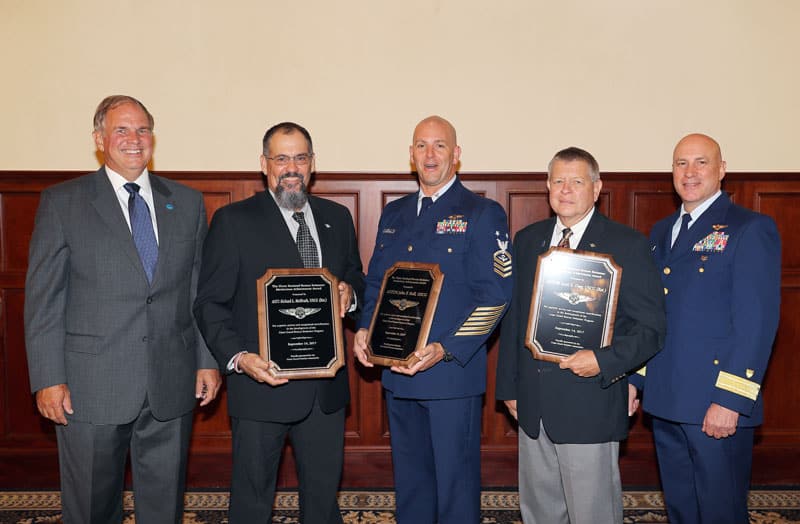During the period of 1 June 2014 to 31 May 2015 LT Crowley exhibited superior performance as both the Flight and Ground Safety Officer for Air Station Houston. Working closely with the Air Station Houston command cadre, LT Crowley worked tirelessly to forge an open reporting culture that was founded on the Just Culture ethos and the Commandant’s core values. As a result, Air Station Houston set the standard for the Coast Guard Aviation Community in mishap response, analysis and reporting all of which culminated in a significant reduction in the Air Station Houston mishap rate.
Master Chief John Hall
Master Chief Hall is cited for his work as the Aviation Survival Technician (AST) Branch Chief at the Coast Guard’s Aviation Technical Training Center (ATTC) in Elizabeth City, NC. Master Chief Hall, with great leadership, technical skill and initiative, has made tremendous training program innovations and recommendations, which have resulted in an expansion of the curriculum to include an AST preparation course for those with orders to AST “A” School, a formalized and fully supported student re-phase program for ASTs in training with minor injuries, formalization of the Operational Fitness Trainer “C” School for field rescue swimmers, and vast improvements to the galley service at Base Elizabeth City to support the nutritional requirements of AST training.
ASTCM Scott Dyer, USCG (Ret.)
Master Chief Scott Dyer is cited for his three decades of dedicated service to the Coast Guard’s Helicopter Rescue Swimmer program. After being one of the first ten Coast Guard graduates of the U.S. Navy’s rescue swimmer school, Master Chief Dyer was instrumental in serving as one of the key instructors who trained and prepared the first CG helo rescue swimmers at 24 field Air Stations. He made lasting contributions to the development of Direct Deployment procedures, the folding Rescue Basket to meet aircraft cabin size restrictions, the Tri-Laminate Dry Suit, the development of CG HH-60 RS procedures, and the development and implementation of Ice Rescue Procedures. As the only Enlisted Branch Chief at the CG’s Aviation Training Center in Mobile, AL, Master Chief Dyer led the Helo RS Standardization Team, ensuring operational procedures were enforced fleet-wide. In addition, he also served as the School Chief for the Advanced Rescue Swimmer School in Astoria, OR, developing and implementing concepts, verifying the curriculum, while evaluating numerous RS procedures and associated equipment. While stationed at CGHQ as the Helo RS Program Mrg., Master Chief Dyer was temporarily detailed to ATC Mobile to supervise & manage all aspects of the Helo RS response during Hurricane Katrina. Finally, Master Chief Dyer also contributed to the RS program by his work contributions as the CG’s Aviation Life Support Equipment Program manager at the Aircraft Repair & Supply Center, now the Air Logistics Center in Elizabeth City, NC.
AST1 Richard “Rick” McElrath, USCG (Ret.)
Petty Officer McElrath is cited for his service of almost 20 years in the Coast Guard as an Aviation Survivalman (ASM) / Aviation Survival Technician (AST). One of the first 20 CG Helicopter Rescue Swimmers, Petty Officer McElrath was a graduate of the CG’s Advanced RS School, and was an exceptional RS at two Air Stations. But, his more important contributions to the CG’s Helicopter Rescue Swimmer Program have come after his CG Service. Serving first as a Field Terminal Operator at AIRSTA Sitka, AK, Petty Officer McElrath maintained the AIRSTA’s aircraft maintenance publications on his own installed intranet to circumvent numerous Internet outages, allowing all types of aircraft maintenance to continue. Moving to the CG’s Air Logistics Center in Elizabeth City, NC, he is the Center’s Aviation Life Support Equipment Specialist, where he has supported the CG’s Helo RS Program either directly, or indirectly. Some of his accomplishments include: revised the COMDT Instruction – Aviation Life Support Manual, created & illustrated an Aviation Life Support Process Guide, revised & published the Shallow Water Egress Training Process Guide used for Shallow Water Egress Training (SWET), created or revised all Aviation Life Support Equipment Maintenance Procedure Cards (MPCs), manages the CG’s Aviation Personal Locator Beacon (PLB) Program (1,800+ PLBs at 25 aviation units), cradle to grave discovery, procurement, testing & evaluation, & implementation of the MH-60T auxiliary hoisting system, ensuring mission success, improved safety, & triple risk mitigation during all hoisting evolutions. His vast and timeless experience and expertise in the CG’s Aviation Life Support Program has proven critical to the success of the office, and to the CG’s Helicopter Rescue Swimmer Program.
